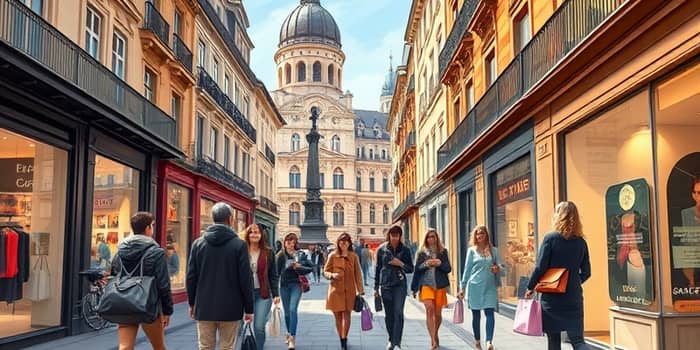
As international travel surges back with unprecedented momentum, luxury goods companies are poised to reap substantial rewards. The interplay between tourism and high-end retail has never been more pronounced, offering a compelling growth narrative for investors and industry stakeholders alike.
By late 2024, global tourism had reached nearly 96% of 2019 levels, with 1.1 billion travelers recorded between January and September—a remarkable 11% increase year-over-year. This resurgence has fueled robust spending in luxury shopping capitals such as Paris, Milan, Hong Kong, and Dubai, underscoring the sector’s deep reliance on tourist dollars.
Investors have taken notice. Publicly listed names like LVMH, Hermès, and Burberry have seen their stock performance buoyed by returning visitors, while niche players such as Moncler and Ferrari continue to thrive on exclusivity and brand prestige. Against this backdrop, luxury equities present a potent opportunity for portfolios seeking both growth and resilience.
The hospitality and tourism sector, valued at $4.9 trillion in 2024, now accounts for $11.1 trillion or 10% of global GDP. As airlines restore capacity and governments relax entry restrictions, major hubs are reporting a rapid and robust recovery in visitor footfall.
Key data points illustrate this trend:
Luxury retailers have strategically capitalized on this wave. From pop-up boutiques at international airports to personalized shopping experiences in flagship stores, brands are capturing incremental sales through targeted promotions and exclusive services tailored to travelers.
Europe has emerged as a clear beneficiary, with luxury market revenues growing by 7% in 2023–2024. American tourists, freed from travel restrictions, have driven spending in Paris and Milan, while Middle Eastern visitors have fueled demand for bespoke Hermès and Dior pieces.
Asia (excluding China and Japan) recorded an 8% expansion, led by Mainland Chinese tourists flocking to Hong Kong, Macau, and Thailand. Duty-free shopping hubs in these regions reported record sales as travelers sought both heritage brands and experiential purchases.
Conversely, the Americas experienced an 8% contraction in domestic luxury sales. However, wealthy consumers redirected their discretionary budgets overseas, bolstering European and Asian retail revenues.
This divergence highlights the importance of geographic exposure and suggests that brands heavily weighted to European and Asian tourism will continue to outperform domestic luxury markets in North America.
Next-generation travelers—Gen Alpha, Millennials, and Gen Z—are reshaping the luxury landscape. These cohorts prioritize transformative experiences over mere transactions and actively seek authenticity in their purchases.
Brands that curate immersive experiences—such as private atelier visits, sustainable sourcing tours, and limited-edition collaborations—are capturing this audience’s attention and driving higher average transaction values.
Despite strong tailwinds, the sector is not immune to challenges. Surveys indicate only 16.3% of American consumers plan to purchase luxury goods in the next 12 months, down from 18.3% the previous year, signaling emerging luxury fatigue in 2025.
Brand consideration scores for major luxury houses (Louis Vuitton, Gucci, Prada, Versace) dipped nearly 25% in early 2025. In China, post-pandemic stimulus measures have yet to reignite spending momentum, leaving brands reliant on potential policy shifts.
Currency dynamics also play a critical role. A weaker euro could enhance the appeal of European-produced goods, but volatility in EUR/USD and CNY pairs necessitates vigilant hedging strategies. Additionally, regulatory changes—such as the removal of tax-free shopping in the UK—could dampen tourist spending if not offset by local incentives.
Regional divergences persist: South Korea’s luxury market lags amid geopolitical tensions, while parts of South America grapple with economic instability, tempering discretionary spending on high-end goods.
Since 2012, Zacks Top 10 stocks—often featuring luxury names—have surged +2,112.6%, vastly outperforming the S&P 500’s +475.6% by late 2024. This trend underscores the resilience of luxury brands during economic cycles.
Analysts remain optimistic for long-term holders, citing strong balance sheets, brand equity, and global distribution networks. Key themes for investors in 2025 include:
Selective exposure to stocks with robust retail strategies and diversified regional footprints will be key. Brands that can pivot quickly to emerging markets or reallocate inventory to in-demand regions will likely outshine peers.
As the world rediscovers the joy of travel, luxury goods stocks stand at the intersection of mobility and memorable consumer experiences. With tourists eagerly spending in iconic fashion capitals and seeking international exposure and tourist dollars, the sector is well positioned for continued growth.
Investors should balance optimism with caution, preparing for potential macroeconomic headwinds and regional divergences. By staying attuned to tourism trends, currency shifts, and evolving consumer preferences, stakeholders can unlock compelling opportunities in this dynamic market.
References













